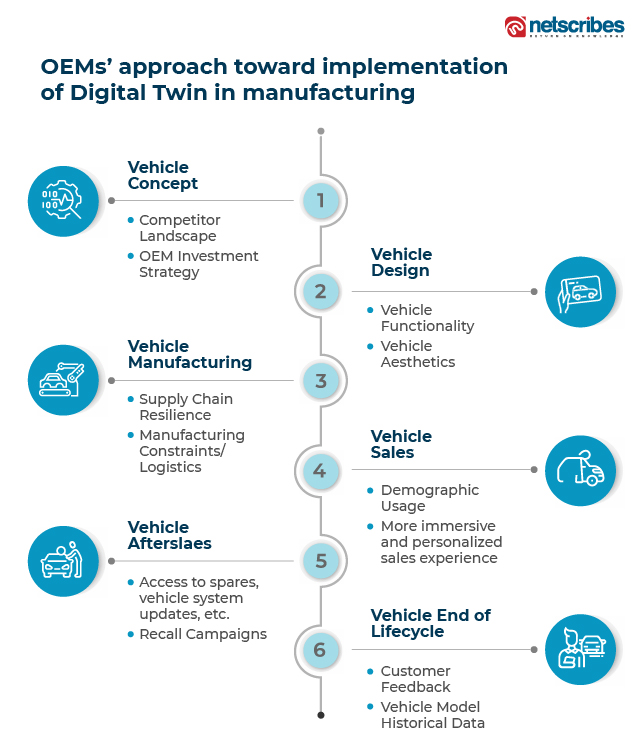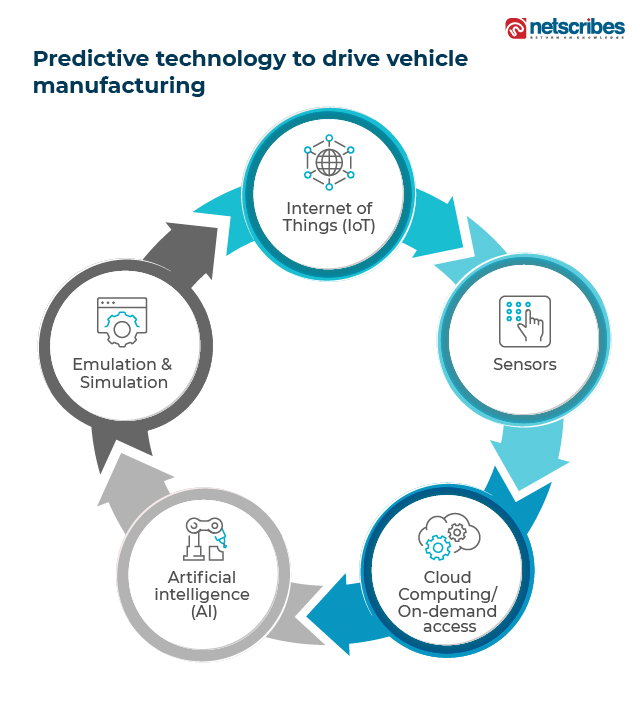Digital twin in the automotive sector is critical for manufacturers to achieve more efficient production lines and faster time-to-market, and it is expected to gain further traction in the first half of this decade as IoT and cloud-based technologies become more widely adopted.
The technology enables the creation of a virtual representation to reliably represent a real-world or artificial system. It is equipped with sensors that collect data on a variety of system performance metrics. The data is then received by a data-acquisition system and applied to the digital copy. Once created, a digital twin can be employed to run two types of simulations as depicted below.
With the prospects of better analyzing the issue, predicting situations, and lowering the overall cost of verifying products, processes, and systems, the technology has a high potential to provide value-added services to automotive manufacturers. Additionally, the concept of a digital twin is a key enabler of data-driven manufacturing.
The significance of using digital twin in automotive is primarily found while performing simulations to reduce testing costs when compared to a physical vehicle test. To streamline operations, OEMs and suppliers should consider the entire supply chain, including manufacturing constraints. A vehicle’s product life cycle includes several stages, beginning from design concept to product recycling. This creates an enormous amount of data generated at each stage of the life cycle. Therefore, the end goal of all OEMs is to leverage this data to create faster, more cost-effective, and higher-quality products.

Digital twin as a technology not constrained to automotive or vehicle development. For instance, the technology is expected to be rapidly implemented for use in automobile manufacturing to optimize productivity, flexibility, and efficiency. Manufacturers can experiment with various materials, colors, and textures using visualization tools before the vehicle moves into the production stage. Furthermore, digital twin technology is being used in the design of autonomous vehicles to give them distinctive looks and interactive mobility options.
Related reading: Digital twins in healthcare: Taking personalized medicine from evolution to revolution
Top players leading the race
Audi: The automaker announced the implementation of a modular assembly concept to drive flexible and efficient production, to support the growing demand for personalization. By using the Digital Twin technology in 2021, Audi was able to save around 37,000 MWh at its Ingolstadt, Germany facility.
BMW: The BMW Group outlined its manufacturing capability and strategy through its all-new Digital Twin-enabled iFactory production lines. The ‘Neue Klasse’ all-electric vehicle lineup is set to go into production in 2025, leveraging state-of-the-art digitized assembly. BMW is expected to digitally twin its 31 production and assembly facilities globally to enhance production and efficiency.
General Motors: GM’s Digital Twin mimics vehicle assembly-floor behavior to assess the integration between operational technology (OT) and information technology (IT) without requiring the physical manufacturing lines to be deployed. The technology spans core areas, such as manufacturing, product design, and battery analytics.
Hyundai/ Kia: Hyundai’s meta-factory will enable the automaker to test various scenarios in the field of smart manufacturing, Artificial Intelligence (AI) training and study, and autonomous driving simulation. The Hyundai Motor Group Innovation Center facility in Singapore (HMGICS) is said to drive this meta-factory digital approach, thereby supporting the company’s initiative to establish an open innovation hub for research and development.
Mercedes-Benz: Mercedes-Benz has established a ‘Digital First’ planning process at its Rastatt, Germany facility, which manufactures the A-Class, B-Class, GLA, and all-electric EQA, and is expected to set up a dedicated platform for future electric vehicles. Furthermore, the Digital Twin platform is expected to synchronize plant locations globally with its in-house MO360 Data Platform and will enable Over-the-Air updates for manufacturing equipment.
Porsche: Porsche has a developed Digital Twin. However, the automaker is focusing this technology on the Taycan all-electric vehicle’s chassis, which can predict future failures and alert the dealership/driver if necessary.
Renault: Renault Group’s Industrial Data Management Platform 4.0 (IDM4.0) constantly monitors 90% of supply flow in the metaverse. According to Renault, 300 alerts have been detected, and 300 production stoppages have been avoided since 2019. Furthermore, 4.0 digitalization of its manufacturing has already resulted in savings of EUR 780 million since 2016, and 2025 will witness various savings worth EUR 320 million alongside cost savings of EUR 260 million on inventories, resulting in a 60% reduction in vehicle delivery time and a 50% reduction in vehicle manufacturing’s carbon footprint.
ŠKODA AUTO: The Czech automaker successfully installed a new robot station, leveraging Digital Twin at its Vrchlabí, Czech Republic component plant. The simulated model enabled ŠKODA AUTO to shorten the project’s overall time by about three weeks. The control software for the robots was designed using the digital twin before the real robots and their components were ever deployed in the factory. Additionally, around 40 square meters of production space was saved due to optimizing the requirements in advance.

Digital twin is a case of a must-have development strategy for automotive manufacturers aiming to deliver next-generation software-defined, connected, and autonomous vehicles. The data accumulated throughout the product lifecycle can be reflected in a single digital interface, bridging gaps across each stage of manufacturing. The digital twin technology is critical for vehicle manufacturers, in particular, to achieve more efficient production lines and faster time-to-market, and Netscribes expects this technology to gain further traction in the first half of this decade. Additionally, the wide adoption of IoT and cloud-based technologies will increase the uptake of digital twin in vehicle manufacturing.
Digital twin technology has great potential to revolutionize the automotive industry by enabling manufacturers to create faster, more cost-effective, and higher-quality products. With the ability to simulate various scenarios and reduce testing costs, digital twin is becoming a must-have development strategy for automotive manufacturers aiming to deliver next-generation software-defined, connected, and autonomous vehicles.
As the adoption of IoT and cloud-based technologies continues to rise, we can expect digital twin innovations to gain further traction in vehicle manufacturing. At Netscribes, we offer comprehensive market, consumer, and technology solutions to help mobility organizations seize market opportunities and stay ahead of the competition. Contact us to learn more about how we can support your business.
Based on insights by Aaryan Vikram, Lead Analyst, Research and Information, Mobility






